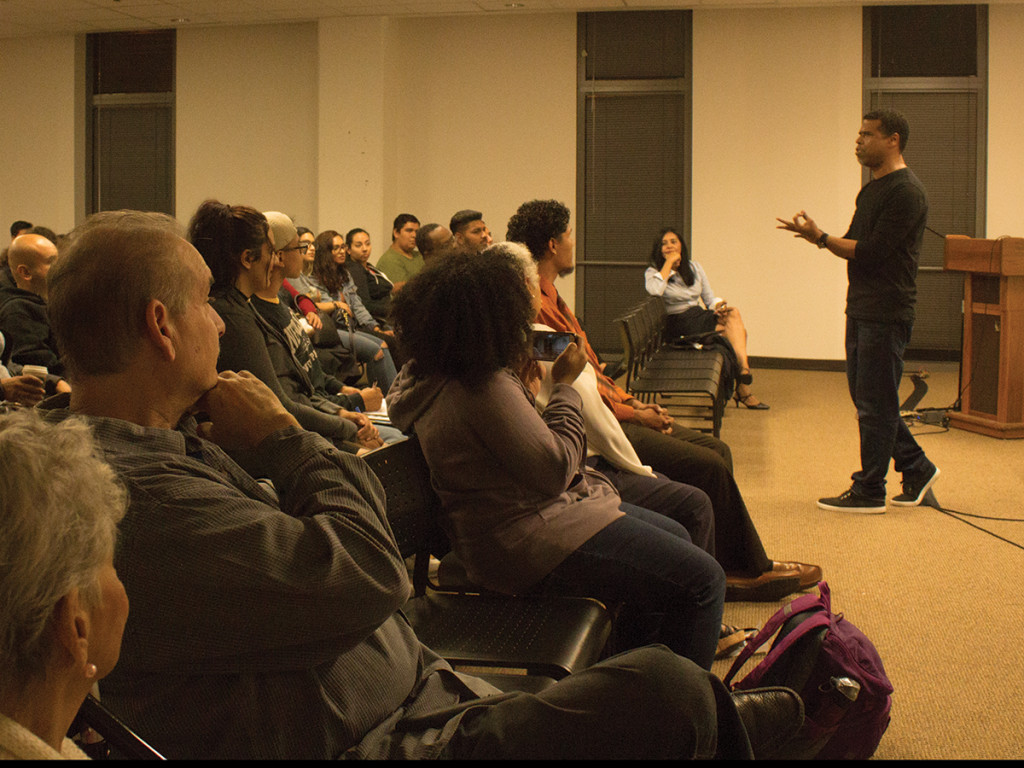
UCR Professor of Playwright for Theater, Film and Theater Production Rickerby Hinds revives attention from the crowd with a personal dialogue on racial discrimination after it was announced the film would not continue to be screened.
By: Adrian Dizon
The power and influence of cinema was very much alive during the documentary film screening of “Nana Dijo” on Thursday, Oct. 13 in INTS 1113. The screening was a collaborative effort hosted by UC Mexus and the Center for Ideas and Society and Cinema Culturas and drew a diverse crowd of students from the local area, academic heads and locals from the Riverside and San Bernardino community, all eager to view the debut film project directed by acclaimed musician and political activist, Bocafloja.
Guided by a “historical responsibility” to “reclaim the narratives from a perspective that is not subjugated to cultural hegemonies” (remezcla.com), director of Nana Dijo, Bocafloja, forged himself into a “multi-disciplinary artist,” using the mediums of filmmaking, theater and literature to continue a global effort in revealing the omnipresent layer of racism that blankets mass media and muffles the cultural authenticity of marginalized people of color. Through his music and spoken word, his words illuminate the outstretched history of cultural oppression which he noted continues to operate covertly in present day America and Latin America. It is through this latest project, “Nana Dijo,” that Bocafloja — along with true filmmakers and storytellers of our day — surfaces the collective feeling of social displacement by those who find themselves in the grey area between Afro-Latino communities.
While attendees filed into the room, grabbed a few frutas y galletas, cleansed their palates with citrus and cilantro-infused water and swivelled into their chairs in anticipation before the program began, none could have predicted the night to go off-course from the standard film screening agenda. What did play out that night, however, would place the attendees in the midst of a more intimate discussion –– the kind that empowers you as you leave the room feeling like the Verizon Man (or Verizon Woman) with millions of people at your side, improving communication with those whom we are divided from or those whom may have been misguided into what is considered the correct way of treating people of color.
As the lights dimmed and the galleta crumbs on one’s lap became hidden within the darkness that enveloped the room, all attention drew to the opening shot of the documentary feature: A black-and-white tracking shot behind the back of a person moving ahead, the frame rate slurred, movement tense and concise. Without a second to dissect the meaning of this introductory visual, a series of stories were told on screen. Although there were no names, no location markers and no information that would normally inform you of who these people are, one was only drawn into the thread which links their personal stories. “I was too Black for the Mexicans, and too Mexican for the Blacks … ,” recounts one of the women on screen whose dual ethnic background left her in a feeling of displacement and in that common conflict of identity.
It would be about five minutes into the film when the screening stopped. Dr. Cony Martinez, director of Cinema Culturas and hostess of the night, announced that due to technical difficulties, the program would continue with the Q-and-A which was initially intended to precede the film.
The atmosphere felt awkward for a moment. Those who had come as fans of Bocafloja, or were invited as guests, expressed their disappointment in exasperated murmurs and sighs. Proceeding with the new plan, the panelists took their seats at the front of the room. One of them, UCR Professor of Playwright for Theater, Film and Theater Production Rickerby Hinds, took the crowd by surprise by denying the microphone and standing confidently in front of the room. His stance was not defensive, nor invasive or showy. He stood with arms comfortably open and welcoming, ready to initiate a new thread of personal narrative, starting with his own. Born in Honduras, Hinds underwent an epiphanic moment of self-discovery and expression while living amongst people that were quick to judge his skin, rather than the content of his character. He spoke of his younger self’s “instinctive need to deny one’s negritude” in those times. Though, now he finds himself much more understanding of society’s racial inequalities. “The darker you are, the deeper you get on the social totem pole.”
The darker you are, the deeper you get on the social totem pole.
Following Hinds, another panelist, Gertrude Lopez, Moreno Valley College Umoja Community coordinator, spoke of the immediate misconception her students had toward her on the first day by not recognizing her as their instructor. Sitting in the front of the classroom in her professional attire (plus suitcase), she waited for 15 minutes before introducing herself. Playing with the unspoken rule of leaving the class if the instructor does not show after 15 minutes, her modus operandi as a community leader revealed how her Ethiopian and Panamanian descent has been a contradiction to those unable to see past the social blinders to color, albeit a childhood element to one’s psyche that can be difficult to remove.
When discussion was opened to the public, a UCR alumni within the attending crowd, stood up amongst the seated “youngsters” of the room to add his personal narrative to the table. Being of Latino descent, his marriage to an African-American woman, also a UCR alumni, proved a disturbance to his community and inner circles. By labeling him with racial remarks and attempting to disable him of his right to exercise love without fear of acceptance, these dissenters continued to play to the tune of racial superiority, and hid behind the defensive contention of racial preservation.
These stories, regardless of whether or not they are spoken through the volume of a microphone, are a part of a larger fabric connected to those whose experiences as marginalized or displaced people can leave them in a realm of isolation. “It is always that I have to explain myself,” said Lopez, “Someone must be someone in order for them to matter in the world,” said a younger Hinds. When panelist, Kendall Smith, of Moreno Valley College department of communications, asked her students if talking about racial issues in the classroom would be the antidote to the problem of difference, they replied, “We’re afraid of offending someone else, or afraid of being offended.”
Although Bocafloja’s film documentary never made it to the ending credits that night, his recognition of film as a medium for fighting injustice and projecting an authentic voice for topics sometimes too taboo or disgraceful for a whisper of recognition was clear. In his interview with Remezcla, an online publication of Latin culture and entertainment, Bocafloja hopes that “Nana Dijo” opens up the discussion for changes in the “fundamental construction” of Latin American countries when considering “identity, morality and systematic procedures” as “anti-black and anti-indigenous.”








